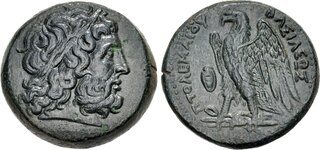| Classical Numismatic Group > Electronic Auction 552 | Auction date: 13 December 2023 |
| Lot number: 138 Price realized: 400 USD (Approx. 371 EUR) Note: Prices do not include buyer's fees. | Show similar lots on CoinArchives Find similar lots in upcoming auctions on |
| Lot description: PTOLEMAIC KINGS of EGYPT. Ptolemy II Philadelphos. 285-246 BC. Æ (27mm, 17.27 g, 12h). Uncertain mint in Sicily. Struck circa 264–263 BC. Laureate head of Zeus right; dotted border / Eagle, wings spread, standing left on thunderbolt; shield to left; dotted border. CPE B288; Svoronos 610; Wolf & Lorber, 'Alexandrian' Style, P01–54; SNG Copenhagen 114. Glossy dark green patina, a hint of smoothing in field on reverse. Good VF. Well centered. Ex Triton XIII (5 January 2010), lot 1352. The series of Ptolemaic bronze coins that display an obviously "Sicilian" style have long puzzled numismatic scholars and collectors. The latest research, by Daniel Wolf and Catharine Lorber in the 2011 Numismatic Chronicle, indicate these coins were struck in Sicily by Hieron II, in alliance with Ptolemy II Philadelphos of Egypt. Hieron was named Strategos (commanding general) of the Greek armies fighting Carthage in Sicily circa 269 BC. He likely made overtures to Ptolemy II, and the Egyptian king probably responded by sending a Ptolemaic contingent of soldiers, along with a large quantity of bronze to be made into coins to pay the troops. The Syracusan die engravers produced a close approximation to the contemporary bronze issues of Egypt, but with a more "western-looking" head of Zeus and lacking the distinctive beveled edges seen on Alexandrian bronzes. This coinage likely ceased in 264/3 BC, when Hieron proclaimed himself king and became embroiled in a conflict against Rome, another ally of Egypt, which then probably ended fiscal and military support for Syracuse. Estimate: 300 USD |  |



